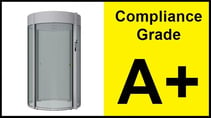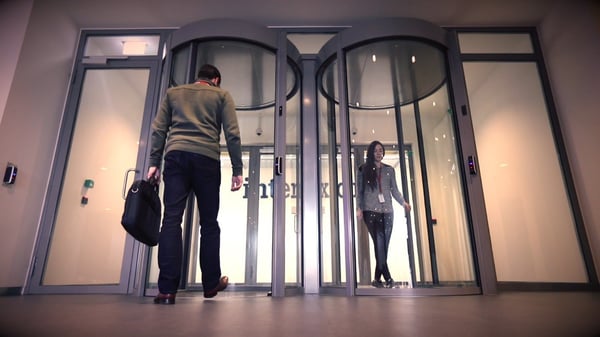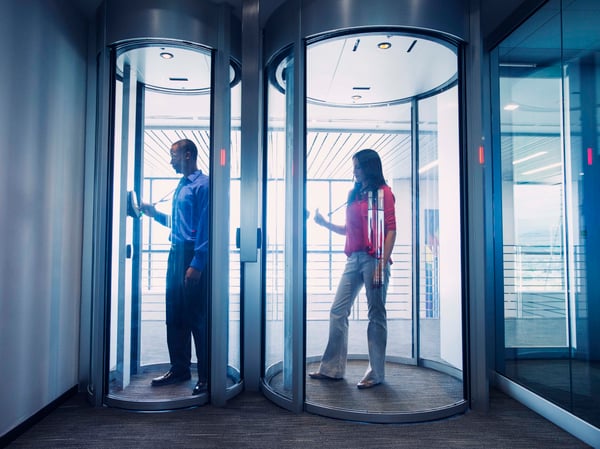Your physical security system must comply with regulations specific to your industry. A regulation that is of major concern to security managers is the requirement to restrict physical access to a building. A failure to comply with this regulation could result in a number of associated liabilities, ranging from physical harm to an employee or guest, to hefty fines and bad press.
Managing the entry to the best of your ability is key to compliance regulations. Security entrances mitigate unauthorized entry, though the level of mitigation various based on the type of entrance implemented. Security mantrap portals receive an A+ grade when it comes to regulatory compliance. What catapults this solution above the other entrance solutions available, like turnstiles and security revolving doors? We’ve got three reasons…
(1) Prevent Tailgating & Piggybacking Every Time
Tripod, full-height and optical turnstiles are effective solutions for mitigating tailgating (one person follows another authorized user into a building, which is a risk with swinging doors). However, each of these solutions can only offer tailgating deterrence or detection. If someone is determined to get in, they are defeatable and require security guard presence to respond to intrusions.
Security portals offer complete tailgating and piggybacking prevention. A sophisticated overhead sensor system scans the interior compartment twice as an authorized user enters – once as they pass the threshold, and again after they are inside and the doors close. This ensures that the user is alone inside the portal for every “transaction.”
 (2) Support the “Intent” of Multi-Factor Authentication
(2) Support the “Intent” of Multi-Factor Authentication
Multi-factor authentication involves the use of two or more credentials to pass through a secure entrance. These credentials can include any combination of an access card, pin code, iris or fingerprint scan, facial recognition, etc. While a variety of entrance solutions can accommodate multi-factor authentication, they are unable to utilize the technology in a way that assures a match of three things for every entering user: Authorization, Credential and Identity.
For example, a company installs optical turnstiles in their lobby and requires each employee to enter a unique pin AND their fingerprint in order to open the barriers and enter. An employee could perform these actions and still allow someone else to walk through the turnstile in their place. The authorization and credential would be correct, but the actual identity of the person entering would be incorrect. Of course, referring back to #1 above, someone could simply tailgate behind the authorized user.
Mantrap portals are the ONLY entrance that support what I would call the “intent” of multi-factor authentication, which is “only one person and the right person.” How? It comes down to their unique design. An employee presents one credential at the outside of the portal. As he steps inside, overhead ceiling sensors confirm he is alone. The doors shut behind him and, essentially, he’s trapped inside for a moment, which is critical to assure the user is alone. Then, a second credential is required inside the portal. This secondary credential system, often a biometric device, confirms the identity of the user, and most importantly, ensures that the identity matches the first credential that was presented outside the portal.
This two-step system provides an unmatched assurance level against intrusion.
(3) Provide Metrics to Predict Risk of Infiltration
When it comes to compliance, having the ability to bring data to the table and show the risk of infiltration at each entrance is extremely beneficial.
Boon Edam’s mantrap portals, the Circlelock and Circlelock Combi, employ a sophisticated overhead sensor technology called StereoVision that has several parameters that security managers can adjust. For example, one parameter includes the system’s sensitivity to piggybacking attempts. If a manager adjusts the sensitivity level higher, it is likely that more individuals will be rejected erroneously, say for wearing a lumpy backpack or fidgeting. Lowering the sensitivity level will decrease rejections but increase the risk of a potential piggybacking breach.
An effective calibration involves striking a balance between convenience and risk – and this balance differs for each organization. But, once these parameters are set, security managers can report a tangible risk percentage to upper management in the form of a percentage that is based on mathematical sampling and product testing, such as, “the risk of a successful piggybacking breach is 5% or lower.”
 Deploying Security Entrances Across a Facility
Deploying Security Entrances Across a Facility
While security portals are an A+ solution when it comes to regulatory compliance, they may not be the best solution for every entry at every application. Compared to other entrance types, mantrap portals have a low throughput level due to their working principle. They are ideal for entering highly sensitive areas where a relatively low number of people are authorized to go, such as data centers, vital records, executive suites, trading floors, etc. For this reason, security entrances should be deployed in layers across a facility – full height turnstiles at the perimeter, optical turnstiles in the lobby, mantrap portals in the interior areas, etc.
To explore the best uses for each type of entrance solution, review a free comparison guide: Finding the Right Security Entrance: A Guide to Comparing Solutions. Then request a free on-site entry assessment performed by our on-staff security consultant who has 20+ years helping organizations comply with industry regulations.
